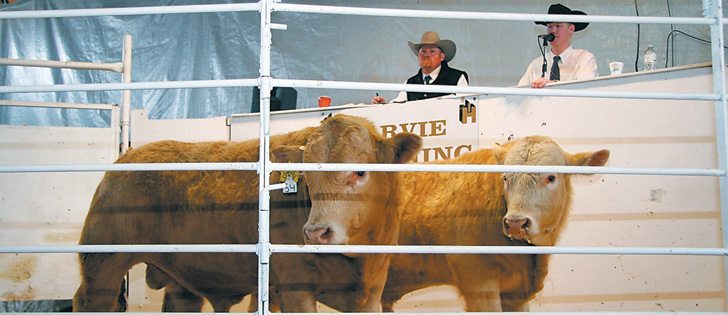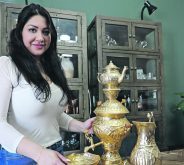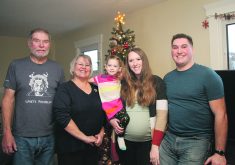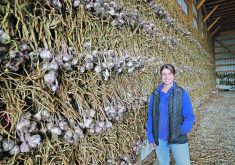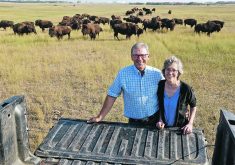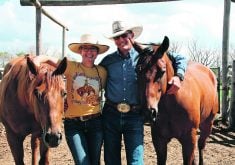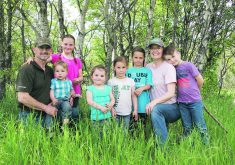Partnership thrives | Three families share workload in purebred operation
OLDS, Alta. — It is the third annual bull sale at Harvie Ranching, where friends and family gather for some western hospitality and a fast paced auction.
Every member of the family is busy, whether it is talking up the bulls sorted in pens outdoors, serving lunch, tending bar, manning the auction block or taking bids on cellphones.
The ranch, located south of Olds near the Alberta foothills, is a family partnership of parents Ian and Marlene Harvie and their sons and wives, Scott and Kerrie and Cole and Jill.
Read Also

AgriStability updates offer stronger support for farmers
One of the most significant updates to the AgriStability program for the 2025 program year is the increase in the compensation rate.
Ian and Marlene married in 1975 and their business and social life revolves around producing purebred Polled Herefords, Charolais and most recently, Simmental.
Land was unaffordable in the Calgary-Priddis region so central Alberta seemed a better choice with its rich soil and good grasslands.
Their sons, Eric, Cole, Scott and Will, always travelled with them to shows and sales. These days, Eric works off the farm and Will is at the University of Alberta.
When Cole and Scott returned after attending college, the workload was distributed and the ranch started to build an international reputation.
“The farm definitely evolved once the boys started getting involved. When there is just two of you, you can only do so much,” said Marlene.
It takes considerable work and co-operation to keep three families on one ranch in tune with one another.
There are monthly meetings to discuss plans, travel and delegate projects and resolve issues.
“Sometimes you just have to get over yourself and realize there are a lot more positives than negatives,” said Jill. “We all have the same goals right now.”
Scott is better with machinery whereas Cole and Marlene spend more time on the computer handling paperwork.
“We all have jobs and it might seem like one brother is working harder at different times of the year but on another day, it balances it out,” said Cole.
They calve out about 250 cows each year. Everything is registered as purebred and sold to customers around the world.
Their breeding program has produced national champions in England, Sweden, Ireland, South America, United States and Australia.
“Our program has taken off a lot since Scott and I came home. We went from AIing a quarter of our herd to 90 percent of our herd,” said Cole.
Expanding into three breeds was a business decision to give customers more choice. Some wanted more performance from crossbreeding with breeds like Charolais or Simmental.
“We decided if you wanted us to find them, we would just raise them for you,” said Scott.
“Whatever you want, we want to be able to sell you a bull rather than have you go somewhere else,” he said.
Offering variety fits into their expansion plans.
“If we can run three breeds, we can open the market to 300 bulls and that will allow us all to stay on the farm and as three partners, it works quite well. We can branch out,” said Scott.
The family holds a bull sale in the spring and a female sale in the fall. Last year, they had an internet-only sale for heifers with pleasing results when buyers and observers logged on from around the world.
“For the last four out of five years, we had the highest averaging Hereford sale in Canada for females,” said Cole.
Selling cattle around the world means promotion and extensive travel.
“Every weekend, it seems someone is on the road trying to promote our breed or look at calves,” Cole said.
Family members are often invited to judge shows or offer workshops and all appreciate the educational aspect of travel.
“Marlene and I have been to Europe 15 times or more and you get a much more in-depth view of that particular area,” said Ian.
They’ve hosted people from South America, Australia, Denmark, Sweden, Finland and Australia.
They have been selling semen and embryos to Europe since the 1980s. Freight costs and health restrictions make it nearly impossible to send live animals offshore.
North Americans vaccinate for diseases like infectious bovine rhinotracheitis and the Europeans will not accept them. Ian figures it is time for Europe to reconsider some of its policies.
“If they did that, it would open markets up substantially more. The embryo thing is pretty aggressive right now but as far as the number of bulls that qualify, it is very limited,” he said.
They will host cattle producers who are attending the World Hereford Congress in Canada this July. The last world event was in Denmark, where Scott was asked to demonstrate Canadian fitting and grooming techniques.
“It was an awesome experience and lots of those people I met over there plan on coming to the World Hereford Congress and quite a few countries have asked to book tours here,” Scott said.
“(Canadians) raise some of the best genetics in the world and that is probably one of the reasons there is so much interest in the World Hereford Congress because people re-spect the Hereford breeders in Canada and like what we do,” he said.
They have also introduced cattle from Australia and New Zealand to freshen up bloodlines. Cattle are also developed to give customers what they want with big, roomy Herefords carrying a dark red coat.
Some of their marketing plans were redirected after 2003 when BSE closed trade on live cattle.
They increased their embryo transplant business, sold more semen and formed more partnerships. Probably 70 head in their herd are partnership cattle.
Ian does not believe they were hurt as badly as the commercial beef business.
“As seedstock people, we weren’t playing on the same field as the commercial people where their physical cow went from $800 to $200. We weren’t selling inventory but the ones we took to town, they were worth the same as anybody else’s,” Ian said.
Community is important to the family and everyone makes time to help those involved in breed association junior programs and 4-H.
When extra help is needed, they can rely on nearby Olds College for students to work on the farm or at shows.
They actively show and judge cattle and use it as a way to promote agriculture and the beef business.
“I don’t think there are enough people showing cattle who realize how important that is to go and take that young kid up to the big bull and show how to walk up there correctly and pet the bull,” said Scott.
“Anything we can do to promote the Canadian beef industry as the best in the world, we are all for it,” he said.
As for the future, the plan involves expansion and continuing to work as a unit.
“We are pretty thankful that Mom and Dad wanted to see the farm expand. There isn’t a bank in the world that would give us a loan to say you can pay them off and they can retire. They would laugh us out the door,” said Scott.
They appreciate the rural lifestyle but recognize this operation is also a business.
“We have to make a living. We have another generation coming up now and we have to make a living so they get the same benefits that we had,” said Cole. He and Jill had their first child last year.
“With our salary, if we went out and worked on the oil rigs, it would be considerably more but we have a trade off because we get to do these trips and visit people. To me, that is definitely a really good perk of our job,” said Scott.
Marlene and Ian do not plan to retire anytime soon.
“We really don’t have any desire to live down south. We like it here and we like being involved with our grandchildren and children,” she said.


